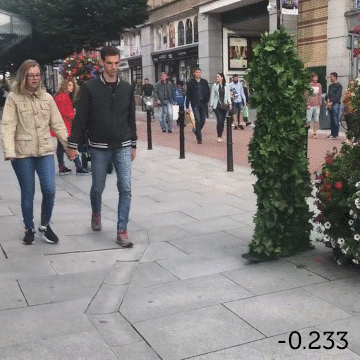
It’s called the startle response–an involuntary reaction initiated within our bodies when we encounter an anomalous event. While it’s common to discuss this phenomenon in the context of the fight-or-flight response, limiting the discussion trivializes the complexity of the underlying biological and neurological processes involved. A closer look reveals the fundamental reason why storytelling plays such an influential role in our lives.
We’ve all experienced the startle response. Perhaps you walked into a darkened room and saw unexpected movement. Instantly, you pulled back, possibly shrieked, before finally recognizing that the movement was tied to a familiar, harmless face. The most amazing thing about this universally human experience is that it only takes about a half-second to occur and I propose that it forms the building blocks for all understanding.
Let’s take a closer look at the startle response. The moment we perceive an anomalous life event, processes deep within the oldest parts of our brains signal the release of a hormone cocktail that increases blood pressure, heart rate, and blood sugar. Simultaneously, a twitch signal travels away from that primitive place in the brain.
Within 20 to 40 milliseconds (one-thousandths of a second) of the initial perception, that signal commands our eyes turn toward the potential threat to gather as much information about it as possible. Between 60 and 120 milliseconds later, our neck muscles turn our heads in the same direction. As the signal proceeds downward through our spinal cords, our shoulders tense (100 to 121 milliseconds) and our arms pull away from the threat and toward the most vulnerable parts of our bodies (125 to 195 milliseconds). Finally, between 145 and 395 milliseconds from the initial perception, that signal hits our legs which propels our bodies away from the perceived threat.
Why do I keep calling this anomaly a perceived threat? Because, our cognitive processes require more time than the 400 milliseconds (0.4 seconds) it took our instinct to distance ourselves from the perceived threat and put us into a defensive position. And therefore, it’s reasonable to assume that the role of instinct is to buy time for our slower cognitive processes to catch up.
Both processes, instinctive and cognitive were signaled simultaneously and proceeded in parallel. While the twitch signal traveled down and away from the primitive part of the brain, it also hit both sides of the frontal cortex–the nonverbal/emotional right hemisphere and verbal/logical left hemisphere. The faster right hemisphere preprocessed the information gathered from the eye/head orientation by presenting a series of uncategorized images to the left hemisphere. Think of the right hemisphere as generating a nonverbal series of hypotheses for the left hemisphere to derive conclusions. Since these nonverbal hypotheses have yet to be categorized, it’s common to experience emotions such as fear. Finally, the left hemisphere completes its (verbal/logical) assessment and ultimately concludes about nature and severity of the threat.
The entire process, from perception to conclusion, takes about a half-second (500 milliseconds)– for all humans, independent upon gender, race, culture, and ideology.
One of my favorite examples of the startle response comes from something called the Bushman Prank, where YouTube personality, Nickxar, blends into the background by wearing an ivy suit and steps toward unsuspecting people. This harmless prank offers a petri dish for us to study the startle effect.
So, let’s take a step-by-step look at a couple reacting to the Bushman Prank.
t = 0.033 seconds before the event, both are walking hand-in-hand relaxed.
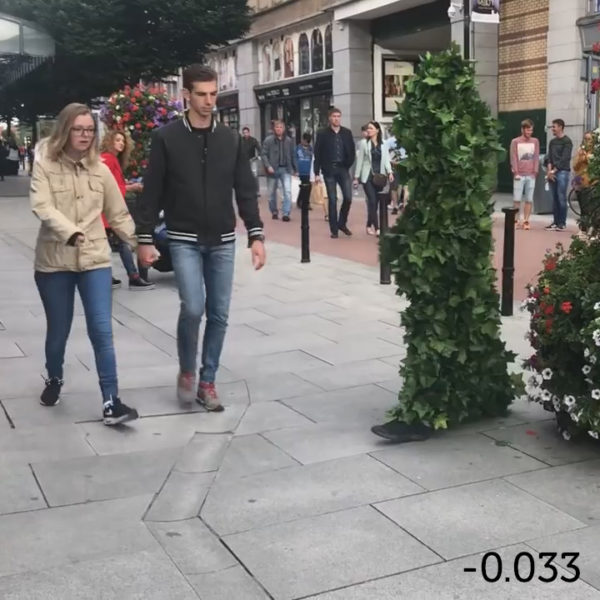
t = 0.00 The startle response appears to have been signaled as both start glancing to their left
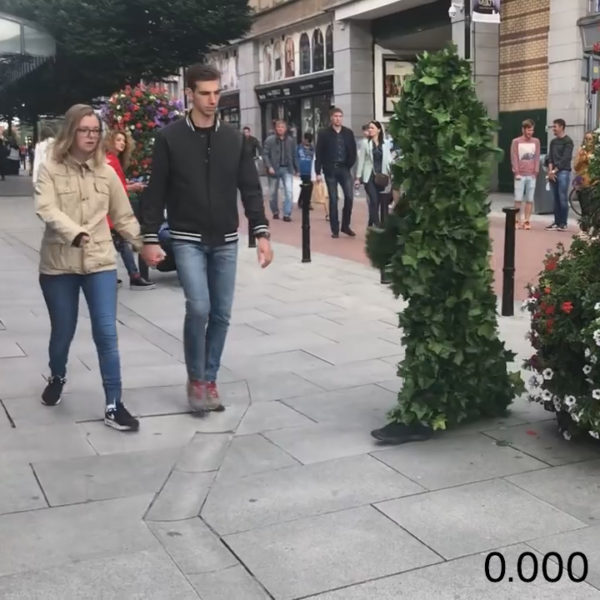
t = 0 .033 seconds: Both heads appear to be turning toward the “threat”

t = 0.100 seconds: The woman begins to pull away quickly, as the combination of her head turning toward the “threat” and her body moving away from it cause her hair to swing. The man’s head continues to turn toward the threat, yet has yet to show any indication of retreat.

t = 0.133 seconds: The woman’s right arm start to draw inward and we see the man’s first sign of retreat as his left arm draws inward and his right shoe lands with its toe pointed away from the threat.

t = 0.167 seconds: The woman is clearly leaning to the left and we see concern on her face. The man’s left arm continues to pull inward.

t = 0.200 seconds: The woman’s right arm is almost completely pulled in and her face shows fright. The man has shifted his weight to his right foot to change his forward momentum away from the perceived threat.
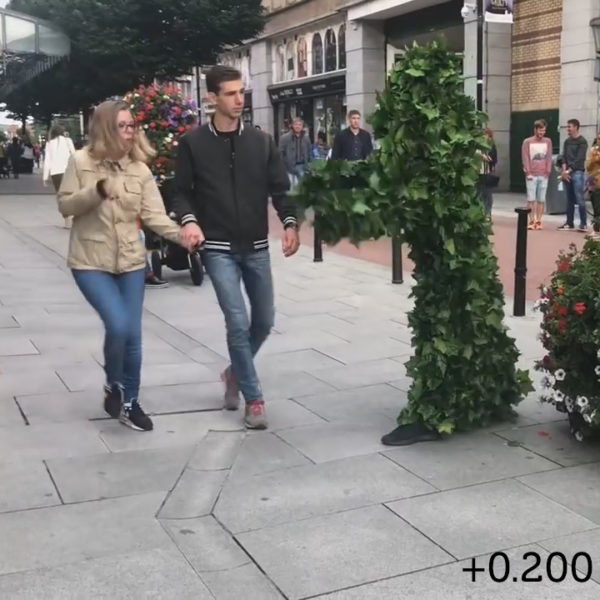
t = 0.233 seconds: The woman is pulling away quickly. The man’s face starts to show concern.
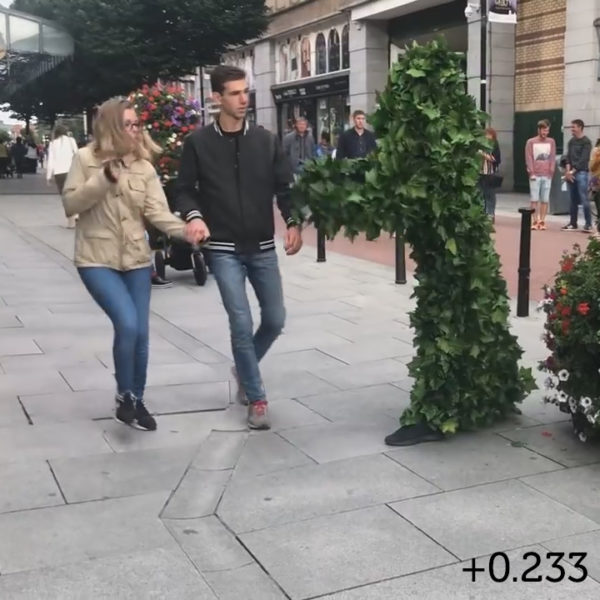
t = 0.267 seconds: Both are now in a full motion of pulling away. The woman’s hand is almost to her face and the man’s arm is still approaching his body.
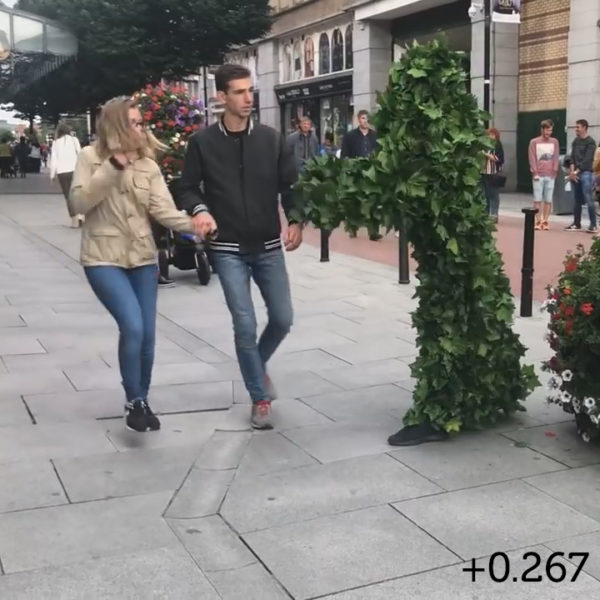
t = 0.333 seconds: The woman shrieks for 0.25 seconds. The man’s face shows some concern.

t = 0.367 seconds: The woman covers her mouth and the man’s left arm is almost pulled to his body.

t = 0.433 seconds: While her hair and right hand obstruct our ability to observe the woman’s face, we see the man’s expression change from concern to the beginning of a smile.

t = 0.500 seconds: Although we still can’t see her face, her body appears to relax, thus offering us an indicator that she has identified the threat. The man’s smile grows as his body appears to relax also.

t = 0.567 seconds: We still can’t see her face because her hand is over her mouth, but her eyes appear to show some sort of recognition. The man’s smile grows.

t = 0.633 seconds: With the situation understood, they both laugh.

t = 1.067 seconds: All in good fun.
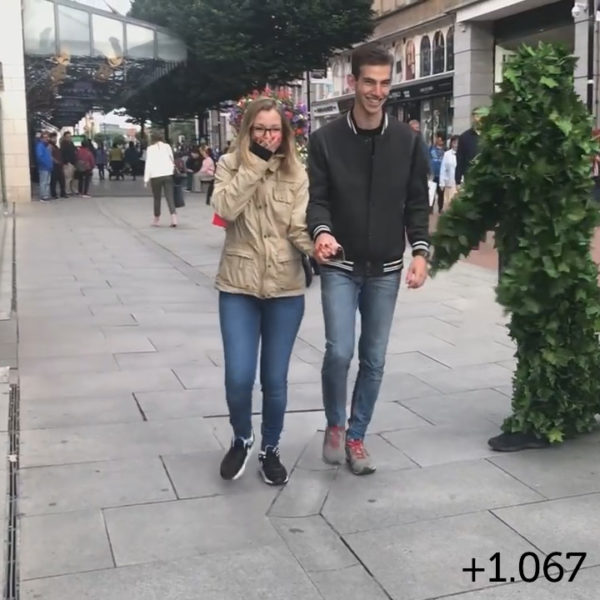
Humans are a messy bundle of instinct, emotion, and logic that help us navigate through a dangerous world. Our best stories are rooted in those universally common moments where each of us were forced to choose between fight, flight, or in the case of the Bushman Prank, delight.
The startle response phenomenon is the atomic building block of all shared human experience. Studying it will lead to the heart of human perception, decisions, and actions–all of which form the elements of a great story.
Sources: